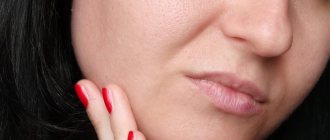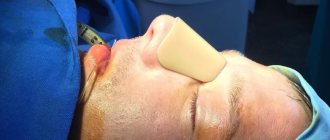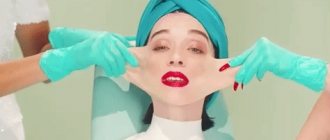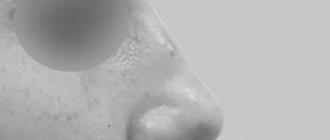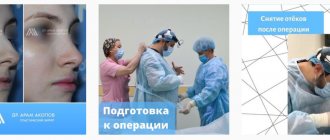Every person has suffered a nose injury at least once in their life. Those at risk include hyperactive children, people involved in martial arts, and military personnel. Statistics show that men are the undisputed leaders in nasal injuries. The nose is most susceptible to various damages due to the peculiarities of its structure and location. Injuries can occur at home, at work, during sports; children often get injured in their nose during active games.
Trauma can damage the bone and cartilage structures of the nose, as well as soft tissues. In this case, a concussion or contusion of the brain often occurs, and in order to exclude various neurological complications with any damage to the nose, you should immediately seek medical help.
Types of nasal injuries
Injuries to the nose can be open, which violate the integrity of the skin, as well as closed, located inside and not causing visible damage to the skin.
According to the severity of the nasal injury, they are classified:
- Soft tissue injuries resulting from contusion, abrasion, stab wound
- Damage affecting the cartilage tissue of the nose with a fracture of the nasal septum
- Fractures of the nasal bones are the most severe injuries to the structure of the nose, in which displacement of bone fragments, damage to the paranasal sinuses and other disorders can occur.
Fractures of the bones of the nasal vault or nasal septum can lead to the following disorders - displacement of the nose from the midline, the formation of a hump, changes in the shape of the nose (widening, flattening or flattening of the nose, retraction of the dorsum downwards), and the bony support of the nose can become soft. Injuries to the nose can result from frostbite, inhalation of steam or chemical (toxic) substances.
Rhinoplasty as a method of rejuvenation
There is a popular myth that a person's nose grows throughout his life. Actually this is not true. It’s just that with age, the facial muscles relax, resulting in tissue drooping, including the nasal tip. This deformation gives a visual effect of enlargement and makes a person’s appearance more “adult”. To reduce it, it is enough to slightly tighten the dermis and redistribute the soft tissues. Thanks to this plastic surgery, the nose will not only become visually smaller, but the face as a whole will look younger.
In conclusion, I would like to note that today the result of high-quality rhinoplasty is considered to be a symmetrical and proportional nose, which looks harmonious against the background of other facial features and does not betray the surgical intervention by its shape and size.
Main signs of nasal damage
When a person gets a nose injury, they experience severe pain, since the nose, like other parts of the face, has many nerve endings. Damage to soft tissue causes swelling and hematoma formation. The following symptoms indicate the presence of serious damage to the nasal structures:
- Bleeding from the nose. Severe and prolonged nosebleeds due to injury are not always due to the degree of damage. It can be caused by hypertension or bleeding disorders.
- Formation of hematomas. When blood vessels are damaged, blood can either leak from the nasal passages or accumulate in the soft tissues. Most often, small hematomas go away on their own, but with extensive hemorrhages, inflammation can occur. In some cases, large hematomas cause problems with nasal breathing.
- Changing the shape of the nose. This symptom indicates serious damage to the bony structures of the nose and often requires immobilization or surgical treatment. These injuries often occur after severe bruises or falls, and therefore are often accompanied by a concussion, and therefore require careful diagnosis and subsequent treatment. When a concussion occurs, patients experience headache, dizziness, nausea, weakness, and loss of consciousness.
Note: how can a girl “hide” a long nose?
Women tend to overestimate the length of the nose, so owners of relatively small noses also complain about the size and shape of the respiratory organ, often simply not knowing how to present their face in a favorable light. Decorative cosmetics will help adjust the length of your nose if you apply them as follows:
- Use two types of foundation : apply a light tone to the back of the nose and bridge of the nose, and a dark tone to the wings and tip. This technique allows you to narrow the wings and make the contour of the nose clear. Foundations should be well shaded, and it’s also a good idea to dust your nose with matte (in no case shimmering or shiny!) powder, which will smooth out the edges and give the face a natural look.
- Girls with a long nose should highlight their eyes or lips more clearly (if they highlight them at the same time, it will turn out vulgar) - this technique allows you to divert attention from the nose. Experts advise giving preference to lipsticks rather than lip gloss.
- Highlight and sculpt your cheekbones with blush in a suitable shade.
- Well-groomed, fairly wide, curved (possibly rounded) eyebrows will help a girl visually correct a long nose - firstly, they will distract attention from it, and secondly, they will “separate” the face in the horizontal plane.
Women with long noses can look elegant and sophisticated if they choose the right hairstyle. The task of making the olfactory organ less noticeable is well accomplished by multi-level (ladder) haircuts, as well as techniques such as highlighting and coloring hair. It has been noticed that the richer and more saturated the hair color, the less attention others pay to the central part of the face, that is, to the nose. In addition, the principle of asymmetry works well - a girl with a long nose goes with bangs and side partings , long hairstyles, curls and curls. What definitely doesn’t work is short haircuts and sleek hairstyles (for example, a ponytail), which visually lengthen the nose.
As for accessories, girls with long noses can safely wear large earrings, glasses with a wide and low bridge, as well as hats with visors and brims.
Treatment of nasal injury
Treatment options vary depending on the degree of damage to the nose due to trauma. For soft tissue bruises without visible damage to bone structures, it is recommended to apply cold. Superficial wounds and abrasions are treated with antiseptics and a sterile bandage is applied. To stop bleeding, it is recommended to lower your head down and press the wings of your nose against the septum for a few minutes, or insert turundas soaked in 3% hydrogen peroxide into the nasal passages for 20-30 minutes.
If the nasal bones are fractured or displaced and there is severe bleeding, you should immediately seek medical help. The doctor must stop the bleeding and determine the degree of damage to bone structures, treatment tactics, and also rule out concussion and other complications.
After stopping the bleeding and pain relief, the doctor restores the displaced bones, followed by fixation. As a rule, timely reposition of uncomplicated nasal fractures does not require surgical treatment, and bone tissue heals on its own within 10–14 days. Old injuries accompanied by a fracture of the nasal bones, complex open or closed fractures require surgical intervention - rhinoplasty of the nose.
If you receive a nose injury, especially if it is accompanied by bone displacement, severe bleeding, or there are open wounds and bone fragments are visible, you must immediately seek medical help. In medical clinics you can receive qualified first aid for any injuries at any convenient time without queues or long waits for an appointment. We can undergo all the necessary diagnostic examinations - x-rays, CT, MRI to exclude possible complications. You can make an appointment with a medical otolaryngologist in St. Petersburg by calling 8(812) 322-93-91.
You can't fool your nose! 14 myths about rhinoplasty that it’s time to talk frankly about
According to statistics, more than 70% of people are dissatisfied with the shape of their nose. But not everyone decides to go under the plastic surgeon’s knife for an upgrade. The reason for this is fears based on rumors. We decided that we should stop being led by myths by the nose. It's time to set the record straight!
Hayk Babayan, leading plastic surgeon at the Sharm Gold plastic surgery clinic
Otari Gogiberidze, leading plastic surgeon at the aesthetic medicine clinic “Time of Beauty”
You thought: you can shape any nose shape.
Actually
it is, but is it necessary? Everything in appearance should be harmonious, so it is better to focus on the individual features of the facial structure of each patient. “A nose that is too small (which has become a trend today) is unlikely to be appropriate in the company of large facial features,” notes Hayk Babayan, leading plastic surgeon at the Sharm Gold plastic surgery clinic. - In addition, the choice of the future nose in some cases depends on the type of skin. If the skin is too porous, oily, or thick, I would not recommend reducing the nose to a critical minimum.” The shape of the face also matters. “If it is oval or elongated, thin, then with a high hump it is undesirable to make the nose with a strong deflection. A higher, smoother, neater back would be more appropriate here,” explains Otari Gogiberidze, the leading plastic surgeon at the “Time of Beauty” aesthetic medicine clinic. - And if a girl has cheeks, then a slightly upturned nose will be just right. We always discuss in detail with the patient both her wishes and my vision as a specialist in order to find the best option.”
You thought: rhinoplasty only makes the nose smaller.
In fact,
they mainly reduce, but not only. Of course, there are many more requests to remove the hump, narrow the wings, and make the tip section more elegant. But there are also the opposite wishes, for example, to lengthen the back, make it higher (popular among people of the Asian race). “In augmentation operations, a person’s own cartilage is used,” says Hayk Babayan. - They are mainly taken from the septum, ribs and ears. It’s very important to calculate all the proportions here; if the nose is raised high, it can become too short.”
You thought: a partially or completely lost nose cannot be restored.
In fact,
reconstructive rhinoplasty has been successfully used in medicine for a long time. Unfortunately, there are serious injuries (accident, burn, dog bite) that require the nose to be reassembled. “I was engaged in purely maxillofacial surgery, and in my practice there were many similar cases,” says Otari Gogiberidze. “For example, there was a patient with a chemical burn to her face, whose entire tip of her nose was affected. We performed an operation on her by transferring a flap from the cheek area, essentially recreating the tip of her nose by placing an allograft (we no longer used her own cartilage). Afterwards, a small corrective operation was performed, and in the end the patient was satisfied with everything. The only thing is that the tip of the nose was different in color, but this can be hidden with decorative cosmetics.
Now, to be honest, I try not to carry out such operations. And patients with severe injuries, as a rule, first turn to maxillofacial surgeons, and after some time they come to aesthetic surgeons.”
You thought: a plastic surgeon is only responsible for the appearance, and not for the health of the nose.
Actually
this is not true. These combined operations are called rhinoseptoplasty. It happens that inexperienced plastic surgeons who do not understand ENT pathology call an ENT specialist for help and perform the operation together with him. But here both our experts are categorical: they consider it unacceptable for two specialists to share one nose. If a plastic surgeon undertakes rhinoplasty, he must know how to correct the respiratory system. “It’s the same as if you came to a tailor, and there one master takes measurements and sews sleeves, another - a vest, and a third cuts a jacket,” plastic surgeon Otari Gogiberidze throws up his hands. “But if for some reason you don’t trust your surgeon, then, of course, it’s better to start by eliminating ENT pathology, and then go for plastic surgery.”
You thought: plastic surgery solves not only the problem of aesthetics, but also snoring.
In fact,
this is an absolute myth. Snoring is the sagging and vibration of the soft palate. This often happens with weight gain and age-related changes in the bite, then at certain positions of the head in sleep a person snores. All this is the responsibility of the ENT doctor, and not the plastic surgeon.
You thought: it is better to have surgery in the cold season.
In fact,
“There is no logical explanation for this statement,” answers Hayk Babayan. - If this were so, then California would not have the status of the capital of plastic surgery. Or take Brazil, which also breaks the record for plastic. After all, in these countries it is summer all year round. The operation does not depend on the time of year, period!”
You thought: during bone crushing you can get a brain injury.
In fact,
“Such a development of events is absolutely excluded,” reassures Gayk Babayan. — Firstly, during osteotomy (bone crushing), the surgeon uses minimal force. The nasal bone is a 1mm thick plate and does not require high impact force. Secondly, modern instruments allow such manipulations to be carried out accurately and quickly. Therefore, there is no reason to worry about a concussion or other injuries.”
You thought: you can’t wear glasses for the first time after rhinoplasty.
In fact,
there are nuances here. Some surgeons put a taboo on glasses for six months, others are sure that even during the rehabilitation period, the frames do not have any effect on the operated nose, however, with one caveat: they are allowed to be worn no earlier than the third or fourth week after rhinoplasty. The frame can indeed leave a temporary dent, but these marks appear only due to tissue swelling. After a light smoothing massage, everything returns to normal. Glasses cannot damage the partition itself in any way.
You thought: a plaster splint is archaic.
In fact,
this statement is baseless. “After rhinoplasty, a splint - plaster, plastic, metal-plastic, whatever - is placed in any case,” warns plastic surgeon Otari Gogiberidze. “Having tried all kinds of these designs, I still end up using plaster, individually made masks. I do them myself and, if necessary, correct them on the fourth beat after the operation. What is all this for? Plaster is a dense medical material that well prevents the spread of edema, fixes bone fragments and protects the nose from external influences. You should wear a plaster splint for 7 to 12 days, depending on the complexity of the operation.”
You thought: after rhinoplasty you can only sleep on your back.
In fact,
your self-preservation instinct will tell you that this is the truth. But if you forget and bury your nose in the pillow during the postoperative period (the first ten days) while sleeping, then, firstly, it will hurt, and secondly, there is a high probability that the nose will move.
You thought: complications often occur after rhinoplasty.
In fact,
“The nose has very good arterial nutrition, so surgical complications are very rare here,” reassures plastic surgeon Gayk Babayan. — But scars, contractures, and adhesions inside the nose are more likely to occur. But all this is very easy to remove in the postoperative period.”
You thought: new noses often have to be remade.
In fact,
it all depends on the surgeon and the chosen clinic. But both of our experts confirm that a very large percentage of patients come to them for revision after unsuccessful rhinoplasty in other clinics. By unsuccessful operations we mean those cases when the patient is dissatisfied with the aesthetics of his nose. Hayk Babayan explains that you can start working on mistakes already three months after the initial operation. But if the case is not critical, then there is no need to rush - the more time passes, the better. True, the percentage of predicting the result with repeated surgery will be lower. “Sometimes you sit and wait for a “fresh” nose to appear,” says Otari Gogiberidze. “Within a month, with three to ten noses a week, you may not encounter a single one that has not been previously operated on. This usually happens when patients save money or are fooled by advertising and end up getting not very high-quality work. But a good doctor will not let the patient go just like that. If there is a need for correction, he does it, the patient should be satisfied. Although there are also cases when the surgeon himself understands that it is with this particular patient that “the hand is not easy,” and then you need to confess and help the patient find another doctor. We will always help each other collectively and achieve the best possible result.”
You thought: you can do rhinoplasty until you get tired of it.
In fact,
unfortunately (or fortunately), it is impossible to operate on the nose indefinitely. Over the course of his entire life, any person can resort to rhinoplasty three or four times, no more. Otherwise, there is a high probability of malnutrition of soft tissues, and this, in turn, threatens the appearance of scars and necrosis (irreversible tissue necrosis). That is why it is better to think carefully, study the market and choose a surgeon who will transform your nose the first time. By the way, you shouldn’t do this before the age of 18; before this age, a person’s facial skeleton has not yet formed. But there is no upper limit.
You thought: it’s difficult to predict how the future nose will turn out.
In fact
, today nothing is impossible, some surgeons trust modern 3D modeling programs, others recognize only manual work, that is, the ability to draw and sculpt to simulate the desired result. Otari Gogiberidze from the Time of Beauty clinic specially took an anatomical modeling course in Austria for this purpose. “We had to, for example, touch an object with our eyes closed and then use clay to recreate it from memory (I had a 70% match). For clients, I draw and show initial versions of noses from photographs, explaining how they can be done and why.”
Suzanne Kloiber - small victory
The last winner in the women's category of the Championship in the German city of Langenbruck in Bavaria was Susanne Kloiber. The judge, using a special measuring device, recorded record values for 2016: 6.95 cm in length and 4.26 cm in width.
However, despite the fact that this time Suzanne had no competitors, Margot Sikora’s 2011 record could not be broken. Also, Miss Kloiber's nose is not as big as that of the current world champion Mehmet Ozyurek. Although, since the anatomical features of the faces of men and women are different, it is incorrect to compare these two heroes. Unfortunately, the Guinness Book does not yet list the woman with the biggest nose in the world.
Physiological characteristics of large noses in men and women
Research conducted by American scientists has led to the conclusion that people with large noses are less likely to suffer from respiratory diseases due to longer nasal passages, in which air is retained somewhat longer, which means it has time to warm up and get rid of some pathogenic microbes. According to statistics, seven percent fewer microorganisms enter the body of those with large noses, as well as plant pollen, which provokes allergy attacks.
Top 10 biggest noses in the world
There is no single official ranking of the largest or longest noses in the world, but anecdotal evidence allows us to identify representatives of humanity whose respiratory organ deserves special attention.
The list of the longest noses in the world includes:
- Thomas Wedders - 19.05 cm.
- Gustav von Albach - 17 cm.
- Mehmet Gul - 12.9 cm.
- Joseph Dewald - 12.7 cm.
- Faizan Agha - 12.19 cm.
- Margot Sikora - 10.16 cm
- Mehmet Ozyurek - 8.8 cm.
- Suzanne Kloiber - 6.95 cm.
- Hans Roest - 6.59 cm.
- Ksenia Gluntsova is an unofficial record holder in Russia.
Faizan Agha is the man claiming a new record
Despite the fact that the official record belongs to a man from Turkey, it is quite possible that he will soon have to make room on the podium, giving his place to another candidate who is also vying for this title. Recently, information appeared on the Internet about a resident of Pakistan with unusual facial proportions. It turns out that the largest nose in the world may belong to a Pakistani man named Faizan Agha. He overtakes Ozyurek, the current leader, by almost four centimeters. However, the record has not yet been officially registered, since Faizan is in no hurry to independently contact representatives of the Book of Records.


